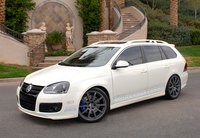Who Needs a Hybrid When You Can Have a Diesel?
2010 Volkswagen Jetta TDI vs. 2010 Toyota Prius
By Thom Cannel
Detroit Bureau
The Auto Channel
Our week long test of a Volkswagen Jetta TDI is a reaction to the newest Prius hybrid from Toyota. We wondered, after achieving an extremely artificial 71.3 mpg in a 2010 Prius, how Prius would compare to a Volkswagen Jetta TDI turbo-diesel driven normally. Thus our real-world excursion from Michigan to New York where, upon arriving in Manhattan, the in-dash computer said we’d sipped fuel at the rate of 50.3 miles per gallon. Driven normally, we would expect a Prius to deliver 60 mpg making fuel economy a virtual tie; the difference in fuel per 10,000 miles would be 23 gallons.
Of course if you’re driving in Manhattan exclusively, or anywhere most miles are driven in very slow stop-start traffic, the Prius would be a great choice (diesels also excel under these conditions). As to the artificial nature of our Prius test, we accelerated tricycle-slowly to 10 mph under any posted limit, coasted whenever possible while "avoiding" stop signs and stop lights, and turned off the air conditioning. Nothing normal at all.
To offer a mainstream driving experience we zeroed the trip odometer, filled the new blue Jetta with fuel and logged 140 miles of regular suburban commuting. You know the drill, the usual grocery runs and hops onto local freeways, daily trips to the mall or local YMCA, and then a full-on single day blast to the Big Apple.
From Michigan to Ohio the road is relatively flat, but I-80 through eastern Ohio and Pennsylvania sucks fuel with every hill. This is where the diesel excels. With 236 pound-feet of torque and 140 horsepower (Prius delivers 105 pound-feet of torque and 98 horsepower) the Jetta never lost a single RPM and never ever felt stressed, or even hard worked. On the drive we kept the speedometer pegged at roughly 8 miles over the posted limit, so we were not attempting any kind of fuel economy run. Our only concession to fuel economy was the same kind of driving techniques that most Americans developed when fuel hit $4 per gallon; no jack-rabbit starts and somewhat less-aggressive throttle application. In contrast, our behavior while driving the Prius struck bicyclists as slow!
It’s the engine that makes the Jetta TDI special. Europeans embraced diesels decades ago because of diesel’s inherently greater fuel economy and later as a lower CO2 emitter. In the US, California focused emissions standards on photochemical pollutants endemic to Los Angeles. With the introduction of low-sulfur fuel the problem of soot (particulate emissions) became easier to control. Diesels are naturally low emitters of hydrocarbons, modern engines even more so. However reducing oxides of nitrogen (NOx) is a major technological problem. Volkswagen, and Audi, use a device that traps nitrous oxide and later consumes it in an exothermic reaction. It is literally burnt off. VW says this technology is applicable in engines up to approximately 2 liters, the displacement of their newest Clean Diesel four-cylinder engine. For V-6 engines the company uses a different system that injects urea into the exhaust stream where it chemically alters nitrous oxide into water vapor. Similar systems are used for all larger diesel engines in the US, regardless of manufacturer.
On the trip we refueled in Pennsylvania and were surprised that the old bugaboo of stinky hands after refueling has disappeared! It must be that stinky hands, stinky exhaust, and the smoke was caused by the aromatic sulfur in US fuels. Now that low-sulfur fuels are here, that nasty chemical aroma is just gone.
Driving in New York City required “brisk” cut-and-thrust driving just to get from A to B in any timely fashion. Hot tip; never activate a turn signal! Stop-and-start driving should have ruined our fuel economy but, upon returning to Michigan, the trip computer read 48.5 miles per gallon. That was our real world experience, from skirmishes in densely populated Manhattan, to pacific urban transport, to high-speed freeway driving while never, ever, focusing on maximizing fuel economy, almost 50 miles to each gallon of fuel. As a data point the official EPA estimate is 28 mpg for city driving and 40 mpg on the highway.
Our conclusion is that small displacement diesels do have a place in our vehicle mix because of their greater torque. VW’s 2.0-liter TDI could easily power a small pickup or Tiguan-sized SUV and offer better payload and towing capacity than larger, less fuel efficient V-6 engines. Most major automobile makers make diesel engines, though some are cooperatively produced. Even though diesels must be more expensive to comply with emissions regulations we would like to have a choice; not everyone buys, or leases, a new vehicle every three years and the 3-5 year payback on diesels makes sense for many. Manufacturers, please let us make that decision.



